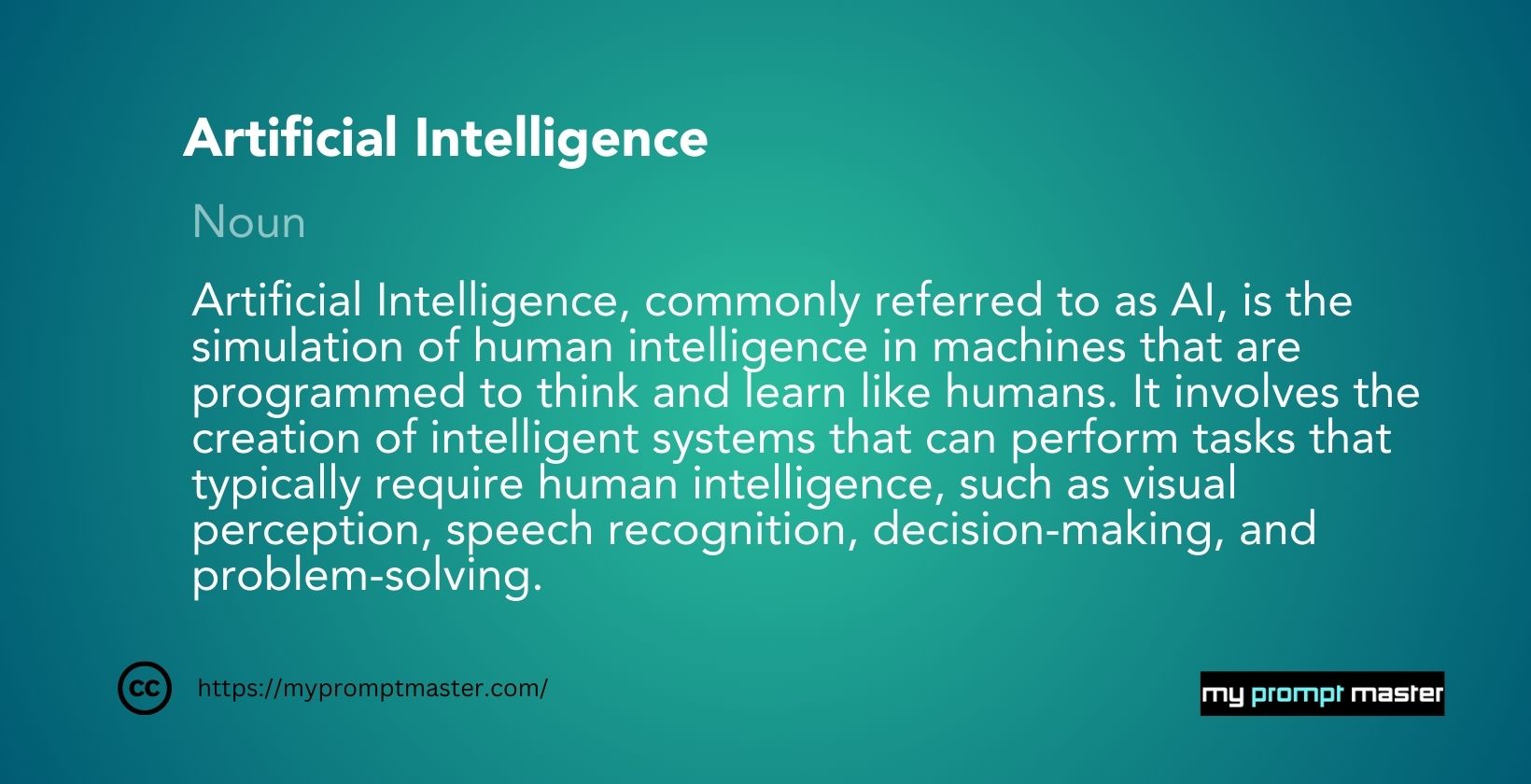Artificial Intelligence, commonly referred to as AI, is the simulation of human intelligence in machines that are programmed to think and learn like humans.
It involves the creation of intelligent systems that can perform tasks that typically require human intelligence, such as visual perception, speech recognition, decision-making, and problem-solving.

Introduction to Artificial Intelligence
Artificial Intelligence refers to the simulation of human intelligence in machines that are programmed to think and learn like humans.
The goal of AI is to develop systems that can perform tasks that normally require human intelligence, such as problem-solving, pattern recognition, and decision-making. These systems are designed to adapt and improve their performance based on experience and new data.
A Brief History of Artificial Intelligence
The concept of Artificial Intelligence dates back to ancient times, with early myths and stories depicting humanoid machines. However, the formal study of AI began in the 1950s, when scientists and researchers started exploring ways to create intelligent machines.
Over the years, AI has gone through periods of significant progress and setbacks, often referred to as “AI winters.” However, recent advancements in computing power and data availability have fueled a resurgence in AI research and applications.
Types of Artificial Intelligence
There are different levels of AI, ranging from narrow AI to general AI and even superintelligent AI.
Narrow AI
Narrow AI, also known as weak AI, is designed to perform specific tasks and has limited capabilities. Examples of narrow AI include voice assistants, recommendation systems, and image recognition software. These systems excel in their designated tasks but lack the ability to perform tasks outside their predefined scope.
General AI
General AI aims to replicate human-like intelligence and can understand, learn, and apply knowledge across various domains. While we have made significant progress in narrow AI, achieving true general AI remains an ongoing challenge. General AI would be capable of performing any intellectual task that a human being can do.
Superintelligent AI
Superintelligent AI surpasses human intelligence in virtually every aspect and is a topic of speculation and debate. This level of AI, if achieved, would possess intellectual capabilities far beyond human comprehension and could potentially lead to significant advancements or concerns.
How Artificial Intelligence Works
Artificial Intelligence systems rely on several techniques and technologies to process information and make decisions. Machine Learning, Deep Learning, and Neural Networks are three key components of AI.
Machine Learning
Machine Learning involves training algorithms to learn patterns from data and make predictions or decisions without being explicitly programmed. It uses statistical techniques to enable machines to improve their performance over time as more data becomes available.
Deep Learning
Deep Learning is a subset of Machine Learning that focuses on artificial neural networks. These networks are inspired by the structure and functioning of the human brain. Deep Learning algorithms learn directly from large amounts of data, automatically extracting relevant features and patterns.
Neural Networks
Neural Networks are a fundamental component of AI that mimics the functioning of the human brain’s interconnected neurons. They consist of layers of artificial neurons that process and transmit information. Neural Networks are crucial in tasks such as image recognition, natural language processing, and decision-making.
Applications of Artificial Intelligence
Artificial Intelligence has found applications in various industries, revolutionizing the way we live and work.
Natural Language Processing
AI-powered Natural Language Processing enables machines to understand and interpret human language. It is used in virtual assistants, chatbots, language translation, and sentiment analysis.
Computer Vision
Computer Vision allows machines to interpret and analyze visual information. It finds applications in facial recognition, object detection, autonomous vehicles, and quality control in manufacturing.
Robotics
AI-powered robots can perform tasks autonomously or collaborate with humans in various industries. They are used in areas such as manufacturing, healthcare, agriculture, and space exploration.
Healthcare
AI is transforming healthcare by enabling more accurate diagnosis, personalized treatment plans, and drug discovery. It helps in analyzing medical images, predicting disease outcomes, and improving patient care.
Finance
In the finance industry, AI is used for fraud detection, algorithmic trading, risk assessment, and customer service chatbots. It enhances decision-making, improves efficiency, and enhances security.
Transportation
AI is driving advancements in self-driving cars, optimizing transportation routes, and improving traffic management. It has the potential to revolutionize the way we commute and transport goods.
Customer Service
AI-powered chatbots and virtual assistants are used in customer service to provide quick and accurate responses, improving customer satisfaction and reducing costs.
The Impact of Artificial Intelligence
The impact of Artificial Intelligence is significant and far-reaching, offering both advantages and challenges.
Advantages of AI
- Increased efficiency and productivity across industries
- Enhanced decision-making based on data analysis
- Automation of repetitive tasks, freeing up human resources for higher-level work
- Improved accuracy and precision in various applications
- Potential for major scientific and medical breakthroughs
Challenges and Concerns
- Job displacement and the need for re-skilling the workforce
- Ethical considerations surrounding AI decision-making and bias
- Data privacy and security concerns
- Potential misuse or unintended consequences of advanced AI systems
- The need for regulations and policies to govern AI development and deployment
The Future of Artificial Intelligence
The future of Artificial Intelligence is promising, with continuous advancements and expanding applications. AI has the potential to transform industries, improve our lives, and tackle some of society’s most significant challenges. However, it is essential to approach its development and implementation responsibly, considering ethical implications and ensuring transparency and accountability.
Conclusion
Artificial Intelligence has emerged as a transformative technology that has the potential to revolutionize various industries and aspects of our daily lives. From narrow AI applications to the pursuit of general AI and beyond, AI offers immense opportunities and challenges. As we move forward, it is crucial to harness its power responsibly, balancing progress with ethical considerations to create a future where AI benefits humanity as a whole.
You May Also Like:
You can visit to check the glossary page of AI, ML, language model, LLM-related terms.


